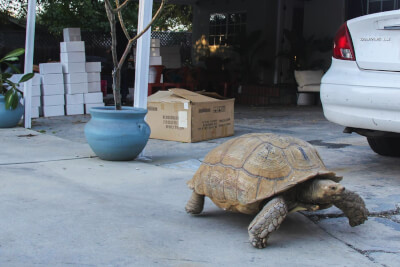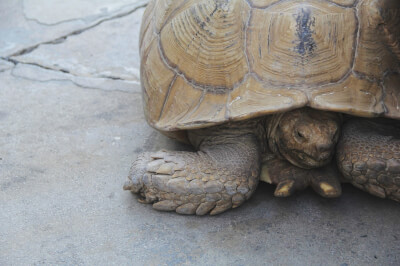
What’s the difference between a tortoise and a turtle? To many, the distinction between these hard-shelled creatures isn’t relevant — their similarities outweigh their differences. But to some residents of Eagle Rock, including Angela Barton and Tammy Sprankle-DiMola, tortoises are meaningful companions and lifelong commitments. An often unrecognized commonality and community-builder among Northeast Los Angeles residents is the ownership of desert tortoises — in Eagle Rock, man‘s best friend may not be canine after all.

Sprankle-DiMola has lived in Eagle Rock her whole life and owns a 17-year-old African Sulcata tortoise named Tank. She said her boyfriend, Jason Casper, got Tank as a baby tortoise, and at the time, he could fit in the palm of his hand. Now, Tank weighs 100 pounds.
According to Sprankle-DiMola, her tortoise is a sweet and easygoing companion. She said Tank lets her pet his head and neck, going so far as to put his nose up to hers — an endearing act of appreciation toward his owner.
Tortoises require more attentive care when they are young, but as they grow, the level of care needed decreases. Sprankle-DiMola said that when Tank was younger, he couldn’t regulate his own body temperature.
“Seven years ago now, when it was really cold here, he hibernated for three months,” Sprankle-DiMola said. “I put him in a big cardboard box and put him in my closet and he hibernated for three months. I didn’t feed him, he didn’t move.”
Now, Sprankle-DiMola said, Tank adjusts to the temperature fluctuations in LA by digging holes in the backyard, a common habit for adult tortoises. According to Sprankle-DiMola, the holes are big enough to fit a small adult.
Angela Barton said she has loved living in Eagle Rock for the past 16 years with her husband. When she was growing up in San Diego, Barton’s family owned a tortoise that she found on the highway when she was seven.
“My brother named him Susie, although we found out years later that he was a boy,” Barton said via email. “That inspired a lot of ‘Boy named Sue’ references (the Johnny Cash song).”
Barton said her family later got a female tortoise from the San Diego Turtle & Tortoise Society in an effort to breed with Susie. Unfortunately, none of the eggs ever hatched because of infertility issues. Now, almost 50 years after Susie was first discovered on the side of the highway, he and his female counterpart live in Portland, Oregon, with Barton’s brother.
Although there is a community cultivated for the ownership of desert tortoises in LA, Barton said she doesn’t believe that LA is the right place for tortoises. Barton said she once had to help a neighbor locate their missing tortoise, and considered herself lucky to have found the animal. Due to the large amounts of traffic and predators in LA, lost tortoises are especially vulnerable.
“I hate to think about a missing tortoise getting out and wandering the heavy traffic and streets of LA,” Barton said.
Sprankle-DiMola said that she believes there’s nothing wrong with owning a tortoise in LA. The animals in the area peacefully coexist with Tank now, and his size secures his safety.
“We have rats in the backyard and I’ll see them in [Tank’s] compound with him eating his food,” Sprankle-DiMola said.
Desert tortoises require a different style of ownership than other house pets. According to Linda Crawford, California Turtle & Tortoise Club adoption chair, tortoises must be kept outside year-round — exposure to sunlight, space to roam and plants such as mulberry, grape leaves, hibiscus and cactus make up the ideal domestic habitat for tortoises.
According to Sprankle-DiMola, Tank eats any kind of vegetable and fruit except citrus. He especially loves lettuce and plums. The only downside to the herbivore diet is the price point of produce in LA, Sprankle-DiMola said.
Barton said tortoise ownership is a big commitment. Tortoises require specific foods and hibernate in ways other pets do not. On average, desert tortoises have a lifespan of 50–80 years, according to the US Fish & Wildlife Service. According to Sprankle-DiMola, long lifespans mean owners have to be prepared for the possibility of being outlived by their tortoises.
“It’s forever. You’re a parent forever,” Sprankle-DiMola said. “You have to think about that, you have to be prepared to take care of it forever and then hopefully have children that will take care of it.”
Supporting the community of owners and those interested in tortoises, the California Turtle & Tortoise Club is active in the community through its Foothill chapter, which oversees Northeast LA and Pasadena, according to Crawford. Crawford said she has acted as adoption chair for 18 years now. As adoption chair, she takes in about 100 turtles and tortoises each year who need new homes and assists in finding them permanent owners.
According to Crawford, the California Turtle & Tortoise Club has 13 chapters in Southern California. Each chapter has monthly meetings and the executive board meets four times a year. Crawford said the Foothill chapter of the California Turtle & Tortoise Club is highly active.
In addition to the need for a proper yard and accommodations such as a permit from the Fish and Wildlife Department, tortoises are difficult to house in other ways, Crawford said. Dogs and small children can prove potentially harmful to tortoises and make ownership difficult.
Sprankle-DiMola said she used to own rabbits and currently owns two dogs, all of which get along well with Tank. According to Sprankle-DiMola, the dogs occasionally bark at Tank but no conflict has arisen from owning both pets. One danger Tank has had to overcome, however, is Sprankle-DiMola’s swimming pool.
“He will drown if he gets in the pool because he will sink,” Sprankle-DiMola said. “I’ll let him out when I’m outside, and if one leg goes over the pool he will turn around and go the [other] way. He’s smart.”
Despite the demanding nature of desert tortoises, there is something that continues to draw individuals towards ownership, according to Barton.
“I think it is the idea of observing a species so different than ours, and one so ancient,” Barton said. “They are obviously not cuddly, but they’re funny and fascinating.”
![]()



































